story and photos by Kayte Deioma
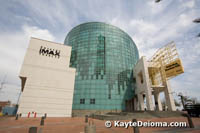 The Audubon Institute’s Aquarium of the Americas in New Orleans has been known as one of the top aquariums in the country since it first opened in 1990. The cylindrical glass building with its sharply angled roof managed to escape major harm from Hurricanes Katrina and Rita and avoided being flooded due to its position on the high banks of the Mississippi. But the power outage that followed the disaster and the failure of the backup generators caused heavy losses to the Aquarium’s sea life. After millions of dollars in repairs and restocking, the Aquarium reopened to the public at the end of May, 2006.
The Audubon Institute’s Aquarium of the Americas in New Orleans has been known as one of the top aquariums in the country since it first opened in 1990. The cylindrical glass building with its sharply angled roof managed to escape major harm from Hurricanes Katrina and Rita and avoided being flooded due to its position on the high banks of the Mississippi. But the power outage that followed the disaster and the failure of the backup generators caused heavy losses to the Aquarium’s sea life. After millions of dollars in repairs and restocking, the Aquarium reopened to the public at the end of May, 2006.
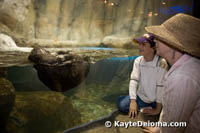 They were able to evacuate a few of the animals to other aquariums, so some familiar faces are back. The colony of African black-footed penguins and Rockhopper penguins survived, as well as the playful sea otters, Emma and Buck, and Mydas the giant green sea turtle.
They were able to evacuate a few of the animals to other aquariums, so some familiar faces are back. The colony of African black-footed penguins and Rockhopper penguins survived, as well as the playful sea otters, Emma and Buck, and Mydas the giant green sea turtle.
Some of the new animals, including large sharks, giant rays and a school of blue runner, were donated by aquariums and zoos around the country. They now make their home in the Gulf of Mexico exhibit.
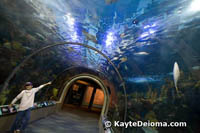 Other new additions were collected by the staff off the Florida Keys for the Caribbean Reef exhibit. TheCaribbean Reef Tunnel puts you under the sea amid intricate coral reefs teaming with life. Schools of fish and kite-shaped stingrays swim over and around you.
Other new additions were collected by the staff off the Florida Keys for the Caribbean Reef exhibit. TheCaribbean Reef Tunnel puts you under the sea amid intricate coral reefs teaming with life. Schools of fish and kite-shaped stingrays swim over and around you.
The ever-popular jelly fish exhibit includes varieties from the miniature comb jellies that look like little light bulbs to the larger crown jellies. Other favorites are the sea horses and the fantastical leafy seadragons.
 Spots, the famous white alligator, still reigns over theMississippi River Gallery. He may lie so still that he looks stuffed, but the staff assures me that he starts getting active when he’s hungry. If you’re lucky, you might witness feeding time, but it only happens once or twice a week. The Mississippi River exhibit is also home to catfish, turtles, a red-tailed hawk, and an owl.
Spots, the famous white alligator, still reigns over theMississippi River Gallery. He may lie so still that he looks stuffed, but the staff assures me that he starts getting active when he’s hungry. If you’re lucky, you might witness feeding time, but it only happens once or twice a week. The Mississippi River exhibit is also home to catfish, turtles, a red-tailed hawk, and an owl.
Another river environment represented is the Amazon and its surrounding rainforest. A boa constrictor, piranhas, spotted rays and a group of turquoise and red macaws are a few of the exotic species found here.
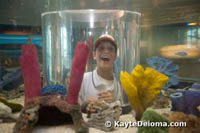 Brand new to the Aquarium in March 2007 is Adventure Island, with a touch pond of cownose rays and a children’s play area where kids can stick their head up in the middle of a fish tank, or climb inside a clam shell with a giant pearl.
Brand new to the Aquarium in March 2007 is Adventure Island, with a touch pond of cownose rays and a children’s play area where kids can stick their head up in the middle of a fish tank, or climb inside a clam shell with a giant pearl.
Up above it all you’ll find the food court featuring Burger King, Papa Jon’s Pizza and Haagen-Dazs Ice Cream. Next door is the repaired and updated Entergy IMAX Theatre, which requires a separate ticket. Several IMAX movies alternate throughout the day.
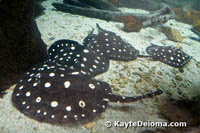 Audubon Aquarium of the Americas
Audubon Aquarium of the Americas
Canal Street at the River
#1 Canal Street
New Orleans, Louisiana 70130
1-800-774-7394
www.auduboninstitute.org
Audubon Aquarium of the Americas is included in the discount New Orleans Pass
Read reviews of Audubon Aquarium of the Americas on TripAdvisor

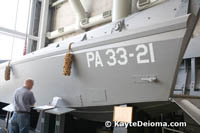 Higgins boats, also known as LCVPs (Landing Craft, Vehicle, Personel), are credited with allowing the allies to win World War II. They’re also the reason that you’ll find theNational World War II Museum in New Orleans. These amphibious vessels were modeled after the Eureka, a flat-bottomed boat designed by New Orleanian Andrew Jackson Higgins to navigate the swamps and bayous of Louisiana by reversing off land banks when they ran aground. The modified version, with a ramp to offload its cargo of one jeep and 12 soldiers, was one of half a dozen military vessels designed and built by Higgins Industries in New Orleans.
Higgins boats, also known as LCVPs (Landing Craft, Vehicle, Personel), are credited with allowing the allies to win World War II. They’re also the reason that you’ll find theNational World War II Museum in New Orleans. These amphibious vessels were modeled after the Eureka, a flat-bottomed boat designed by New Orleanian Andrew Jackson Higgins to navigate the swamps and bayous of Louisiana by reversing off land banks when they ran aground. The modified version, with a ramp to offload its cargo of one jeep and 12 soldiers, was one of half a dozen military vessels designed and built by Higgins Industries in New Orleans.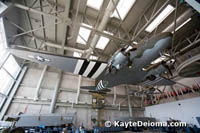 A replica of an LCVP, built according to the original plans, is on display in the Louisiana Memorial Pavilion at the National WWII Museum. The relatively small craft is overshadowed by the Douglas C-47 hanging overhead in the cavernous space. Other military vehicles on display in the Pavilion include a US tank, and jeeps, a German motorcycle and Howitzer, and a Supermarine Spitfire airplane from the British Royal Air Force.
A replica of an LCVP, built according to the original plans, is on display in the Louisiana Memorial Pavilion at the National WWII Museum. The relatively small craft is overshadowed by the Douglas C-47 hanging overhead in the cavernous space. Other military vehicles on display in the Pavilion include a US tank, and jeeps, a German motorcycle and Howitzer, and a Supermarine Spitfire airplane from the British Royal Air Force.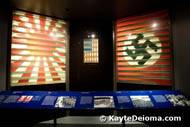 There’s a clear progression through the galleries. You begin with the build up to war and the imbalance of military forces. A graphic display using miniature soldiers against national flags shows how under-armed the American military was compared to the massive build up of forces in Germany and Japan. Even Italy had three times the military might of the U.S before the United States was forced into the war.
There’s a clear progression through the galleries. You begin with the build up to war and the imbalance of military forces. A graphic display using miniature soldiers against national flags shows how under-armed the American military was compared to the massive build up of forces in Germany and Japan. Even Italy had three times the military might of the U.S before the United States was forced into the war.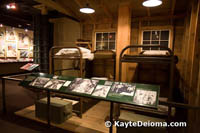 America Goes to War shows how the military buildup in America affected the people at home, from the implementation of the draft to women and minorities landing higher paying jobs in factories. Stacks of tires and piles of artillery shells demonstrate how sacrifices at home supplied the war effort. You can see the 1943 pennies made of steel so that the copper could be used for communication wire on the battle fields.
America Goes to War shows how the military buildup in America affected the people at home, from the implementation of the draft to women and minorities landing higher paying jobs in factories. Stacks of tires and piles of artillery shells demonstrate how sacrifices at home supplied the war effort. You can see the 1943 pennies made of steel so that the copper could be used for communication wire on the battle fields.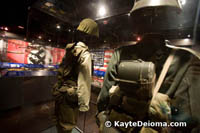 In the War in Europe section you can compare the uniforms of American and German soldiers as well as the weapons with which they were armed. You can also take a look inside a GI’s pockets to see what he would have been carrying, from his toothbrush and extra socks to shaving cream and toilet paper.
In the War in Europe section you can compare the uniforms of American and German soldiers as well as the weapons with which they were armed. You can also take a look inside a GI’s pockets to see what he would have been carrying, from his toothbrush and extra socks to shaving cream and toilet paper.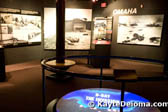 150,000 troops on the shores of Normandy in France on June 6, 1944 in what is now known as D-Day. This military reference to the undisclosed day an operation is to be implemented actually applies to every operation, but in common parlance, it refers to the execution of Operation Overlord. A tableau shows the density of ships and aircraft crossing the English Channel.
150,000 troops on the shores of Normandy in France on June 6, 1944 in what is now known as D-Day. This military reference to the undisclosed day an operation is to be implemented actually applies to every operation, but in common parlance, it refers to the execution of Operation Overlord. A tableau shows the density of ships and aircraft crossing the English Channel.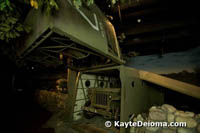 The strategy is laid out in personal stories of the assault by American, British and Canadian troops on five different French beaches. The stories of Omaha Beach, where American soldiers met the greatest German resistance, are accompanied by the compelling photos of the onslaught by the famous war photographer Robert Capa.
The strategy is laid out in personal stories of the assault by American, British and Canadian troops on five different French beaches. The stories of Omaha Beach, where American soldiers met the greatest German resistance, are accompanied by the compelling photos of the onslaught by the famous war photographer Robert Capa.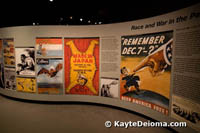 sides of the battle. Photos and stories illustrate the challenging physical conditions faced by soldiers and the heavy losses due to disease. A series of D-Day panels shows a timeline of D-Days for major operations in the Pacific theatre. TheAtom Bomb display is located at the bend in the hallway leading to Victory in the Pacific around the corner.
sides of the battle. Photos and stories illustrate the challenging physical conditions faced by soldiers and the heavy losses due to disease. A series of D-Day panels shows a timeline of D-Days for major operations in the Pacific theatre. TheAtom Bomb display is located at the bend in the hallway leading to Victory in the Pacific around the corner.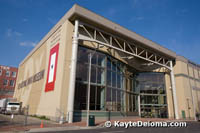 If you read everything and watch the videos, you could spend all day. There are plenty of exhibits that are relatively self-explanatory without reading all the informational panels if you’re pressed for time, or not a big museum reader. If you want to do the reading at home before you go, check out the history section of the museum’s website. It provides much of the information on the extensive exhibit panels. Then you can spend your museum time studying the artifacts and photos.
If you read everything and watch the videos, you could spend all day. There are plenty of exhibits that are relatively self-explanatory without reading all the informational panels if you’re pressed for time, or not a big museum reader. If you want to do the reading at home before you go, check out the history section of the museum’s website. It provides much of the information on the extensive exhibit panels. Then you can spend your museum time studying the artifacts and photos.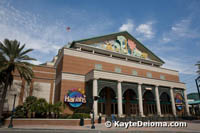 In 1999, Harrah’s newly built 115,000 square foot gambling palace became the first land-based casino in New Orleans. Located at the edge of the business district, across from the French Quarter and the
In 1999, Harrah’s newly built 115,000 square foot gambling palace became the first land-based casino in New Orleans. Located at the edge of the business district, across from the French Quarter and the 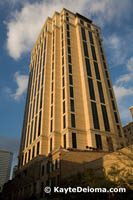 waterfront, the establishment weathered the hurricanes and flood of 2005 much better than its riverboat competition and was quick to reopen after the storm. They also got right back to work on the hotel tower which they had begun building on top of a historic building across the street from the Casino. Despite all the competition for labor and materials, the new luxury 450-room hotel was completed in record time and opened in September 2006, before some of the older hotels had completed repairs.
waterfront, the establishment weathered the hurricanes and flood of 2005 much better than its riverboat competition and was quick to reopen after the storm. They also got right back to work on the hotel tower which they had begun building on top of a historic building across the street from the Casino. Despite all the competition for labor and materials, the new luxury 450-room hotel was completed in record time and opened in September 2006, before some of the older hotels had completed repairs.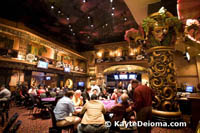 The inside of the Casino is decorated with a New
The inside of the Casino is decorated with a New 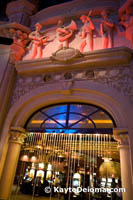 Orleans theme. Mardi Gras jesters smile down from the top of columns. French Quarter balconies are suspended over the poker room. Streamers surround the Masquerade nightclub and bas-relief jazz allegories march around the top of the room.
Orleans theme. Mardi Gras jesters smile down from the top of columns. French Quarter balconies are suspended over the poker room. Streamers surround the Masquerade nightclub and bas-relief jazz allegories march around the top of the room.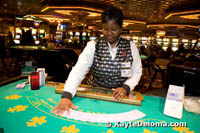 Gambling opportunities at Harrah’s New Orleans include 2100 coinless slot machines with many
Gambling opportunities at Harrah’s New Orleans include 2100 coinless slot machines with many 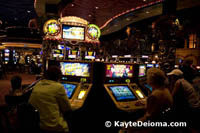 different themes such as the new Party Gras five-reel and multi-denominational machines, as well as video poker. There are 92 table games including Blackjack, Craps, Roulette, Big Six Wheel, Let It Ride, MiniBacc Dragon Bonus, and Baccarat by request. There are 23 tables in the French Quarter themed poker room. In addition to regular poker tournaments and tours, daily games include 3 and 4 Card Poker, Pai Gow Poker, Texas Hold ‘Em, Pot Limit Omaha, Caribbean Stud, and 7 Card Stud.
different themes such as the new Party Gras five-reel and multi-denominational machines, as well as video poker. There are 92 table games including Blackjack, Craps, Roulette, Big Six Wheel, Let It Ride, MiniBacc Dragon Bonus, and Baccarat by request. There are 23 tables in the French Quarter themed poker room. In addition to regular poker tournaments and tours, daily games include 3 and 4 Card Poker, Pai Gow Poker, Texas Hold ‘Em, Pot Limit Omaha, Caribbean Stud, and 7 Card Stud.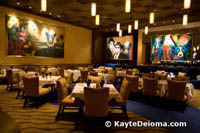 You can get everything from Starbucks coffee to haute cuisine inside the Casino and Hotel. At the top end are the French-influenced restaurant Riche by celebrity chef Todd English inside the hotel, and in the Casino, the Besh Steakhouse by New Orleans’ own much-acclaimed chef John Besh of Restaurant August fame. In the mid-range you’ll find the popular Asian fusion restaurant Bambu Asian Grill and Sushi Bar, and Harrah’s Buffet, which is more like a food court with different counters offering different cuisines all for one price. For a quick bite, the Cafes on Canal include a Starbucks, Fudruckers (burgers) and McAlister’s. Harrah’s Buffet is the only thing open for hard core all-night gamblers.
You can get everything from Starbucks coffee to haute cuisine inside the Casino and Hotel. At the top end are the French-influenced restaurant Riche by celebrity chef Todd English inside the hotel, and in the Casino, the Besh Steakhouse by New Orleans’ own much-acclaimed chef John Besh of Restaurant August fame. In the mid-range you’ll find the popular Asian fusion restaurant Bambu Asian Grill and Sushi Bar, and Harrah’s Buffet, which is more like a food court with different counters offering different cuisines all for one price. For a quick bite, the Cafes on Canal include a Starbucks, Fudruckers (burgers) and McAlister’s. Harrah’s Buffet is the only thing open for hard core all-night gamblers.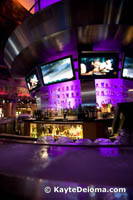 Whether you want to watch, listen or get up and dance, there are plenty of evening entertainment options at Harrah’s. For the foreseeable future,Hats! The Musical is playing in the 500-seat Harrah’s Theatre. Hats! The Musical celebrates women over fifty through the story of a woman about to have a birthday and a group
Whether you want to watch, listen or get up and dance, there are plenty of evening entertainment options at Harrah’s. For the foreseeable future,Hats! The Musical is playing in the 500-seat Harrah’s Theatre. Hats! The Musical celebrates women over fifty through the story of a woman about to have a birthday and a group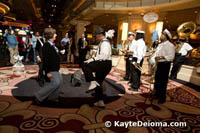 of older women giving her something to look forward to. The Ice Bar at Masquerade Nightclub features live bands on Wednesdays, happy hour specials and a unique video tower above the bar as well as more gaming right in the club. The 528 by Todd English jazz club is off of Riche Restaurant and Fulton Street in the hotel tower. The Harrah’s Mardi-Gras-style jazz band parades through the Casino concourse periodically to liven things up.
of older women giving her something to look forward to. The Ice Bar at Masquerade Nightclub features live bands on Wednesdays, happy hour specials and a unique video tower above the bar as well as more gaming right in the club. The 528 by Todd English jazz club is off of Riche Restaurant and Fulton Street in the hotel tower. The Harrah’s Mardi-Gras-style jazz band parades through the Casino concourse periodically to liven things up.